Heat Transfer Analysis and Effects of (Silver and Gold) Nanoparticles on Blood Flow Inside Arterial Stenosis
Abstract
:1. Introduction
| Causes | Symptoms | Complications |
| Birth defects, build-up of calcium, radiation therapy and rheumatic fever. | Chest pain, heart palpitations, swollen ankles or feet and difficulty in walking short distances. | Stroke, heart failure, blood clots, arrhythmias and endocarditis. |
2. Materials and Methods
2.1. Continuity Equation
2.2. Equation of Motion
2.3. Energy Equation
2.4. Boundary Conditions
2.4.1. The Inlet
2.4.2. The Outlet
2.4.3. At the Wall
2.4.4. Thermal Insulation
2.5. Computational Mesh
3. Validation
4. Results
5. Conclusions
- The laminar flow study showed that the velocity of the blood flow varies throughout the model due to arterial plaque. The maximum velocity of the blood flow was 1.59 m/s at t = 0.1 s;
- The streamlines showed abnormal behavior near the stenosis area and that recirculation occurred as the intensity of the stenosis increased; however, the flow was normal when nanoparticles were added;
- The isothermal contours displayed the results clearly on colored surfaces at t = 0.1, 0.7 and 1 s;
- The temperature and Nusselt number curves varied for slight variations of time;
- The pressure profiles also manifested clear patterns near the stenosed region;
- We can further study the physical qualities, such as skin friction coefficient, and also analyze the problem using radiation and magnetohydrodynamic effects to understand the reasons for stenosis, which may help in the treatment of arterial stenosis.
Author Contributions
Funding
Institutional Review Board Statement
Informed Consent Statement
Data Availability Statement
Acknowledgments
Conflicts of Interest
References
- Hayat, T.; Nadeem, S. Heat transfer enhancement with Ag-CuO/water hybrid nanofluid. Results Phys. 2017, 7, 2317–2324. [Google Scholar] [CrossRef]
- Nadeem, S.; Ijaz, S. Single wall carbon nanotube (SWCNT) examination on blood flow through a multiple stenosed artery with variable nanofluid viscosity. AIP Adv. 2015, 5, 107217. [Google Scholar] [CrossRef] [Green Version]
- Ghadikolaei, S.; Gholinia, M. Terrific effect of H2 on 3D free convection MHD flow of C2H6O2H2O hybrid base fluid to dissolve Cu nanoparticles in a porous space considering the thermal radiation and nanoparticle shapes effects. Int. J. Hydrog. Energy 2019, 44, 17072–17083. [Google Scholar] [CrossRef]
- Ghadikolaei, S.; Gholinia, M.; Hoseini, M.; Ganji, D. Natural convection MHD flow due to MoS2-Ag nanoparticles suspended in C2H6O2H2O hybrid base fluid with thermal radiation. J. Taiwan Inst. Chem. Eng. 2019, 97, 12–23. [Google Scholar] [CrossRef]
- Ijaz, S.; Sadiq, M.A. Inspiration of Induced Magnetic Field on a Blood Flow of Prandtl Nanofluid Model with Stenosis. Curr. Nanosci. 2014, 10, 753–765. [Google Scholar] [CrossRef]
- Elnaqeeb, T.; Shah, N.A.; Mekheimer, K. Hemodynamic Characteristics of Gold Nanoparticle Blood Flow Through a Tapered Stenosed Vessel with Variable Nanofluid Viscosity. BioNanoScience 2019, 9, 245–255. [Google Scholar] [CrossRef]
- Nadeem, S.; Ijaz, S.; Akbar, N.S. Nanoparticle analysis for blood flow of Prandtl fluid model with stenosis. Int. Nano Lett. 2013, 3, 35. [Google Scholar] [CrossRef] [Green Version]
- Ahmed, A.; Nadeem, S. Biomathematical study of time-dependent flow of a Carreau nanofluid through inclined catheterized arteries with overlapping stenosis. J. Cent. South Univ. 2017, 24, 2725–2744. [Google Scholar] [CrossRef]
- Ijaz, S.; Nadeem, S. Examination of nanoparticles as a drug carrier on blood flow through catheterized composite stenosed artery with permeable walls. Comput. Methods Programs Biomed. 2016, 1339, 83–94. [Google Scholar] [CrossRef] [PubMed]
- Akhtar, S.; McCash, L.B.; Nadeem, S.; Saleem, S.; Issakhov, A. Mechanics of non-Newtonian blood flow in an artery having multiple stenosis and electroosmotic effects. Sci. Prog. 2021, 104, 1–15. [Google Scholar] [CrossRef] [PubMed]
- Liu, J.; Wang, G.; Zhang, L.; Shi, Y.; Zhang, H.; Yao, S.-C. Numerical simulation of single bubble boiling behavior. Propuls. Power Res. 2017, 6, 117–125. [Google Scholar] [CrossRef]
- Hussain, A.; Hassan, A.; Al Mdallal, Q.; Ahmad, H.; Rehman, A.; Altanji, M.; Arshad, M. Heat transportation enrichment and elliptic cylindrical solution of time-dependent flow. Case Stud. Therm. Eng. 2021, 27, 101248. [Google Scholar] [CrossRef]
- Choudhari, P.; Panse, M. Finite Element Modeling and Simulation of Arteries in the Human Arm to Study the Aortic Pulse Wave Propagation. Procedia Comput. Sci. 2016, 93, 721–727. [Google Scholar] [CrossRef] [Green Version]
- Durantes, R.; Moon, J.; Pacheco, R.; Pacheco-Vega, A. Numerical Modeling of Single-Phase Fluid-Flow in Wavy Micro-Channels. In White Papers and Application Notes; California State University-Los Angeles: Los Angeles, CA, USA, 2020; Available online: https://www.comsol.com/paper/numerical-modeling-of-single-phase-fluid-flow-in-wavy-micro-channels-9371 (accessed on 28 November 2021).
- Ghadikolaei, S.; Gholinia, M. 3D mixed convection MHD flow of GO-MoS2 hybrid nanoparticles in H2O-(CH2OH)2 hybrid base fluid under the effect of H2 bond. Int. Commun. Heat Mass Transf. 2020, 110, 104371. [Google Scholar] [CrossRef]
- Tripathi, J.; Vasu, B.; Bég, O.A.; Gorla, R.S.R. Unsteady hybrid nanoparticle-mediated magneto-hemodynamics and heat transfer through an overlapped stenotic artery: Biomedical drug delivery simulation. Proc. Inst. Mech. Eng. Part H J. Eng. Med. 2021, 235, 1175–1196. [Google Scholar] [CrossRef] [PubMed]
- Nasrin, R.; Hossain, A.; Zahan, I. Blood flow analysis inside a stenotic artery using Power-Law fluid model. RDMS 2020, 13, 1–10. [Google Scholar] [CrossRef]
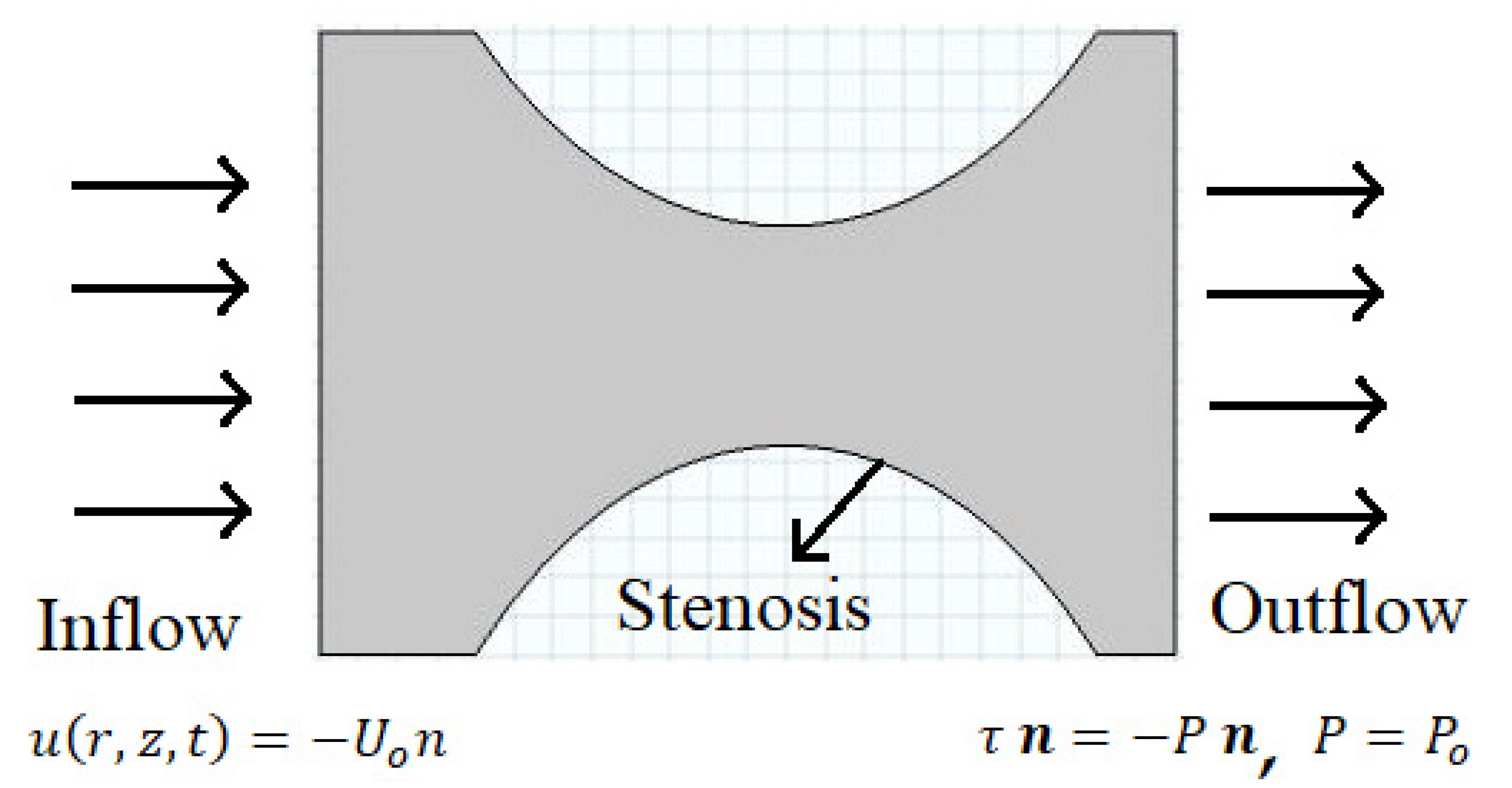
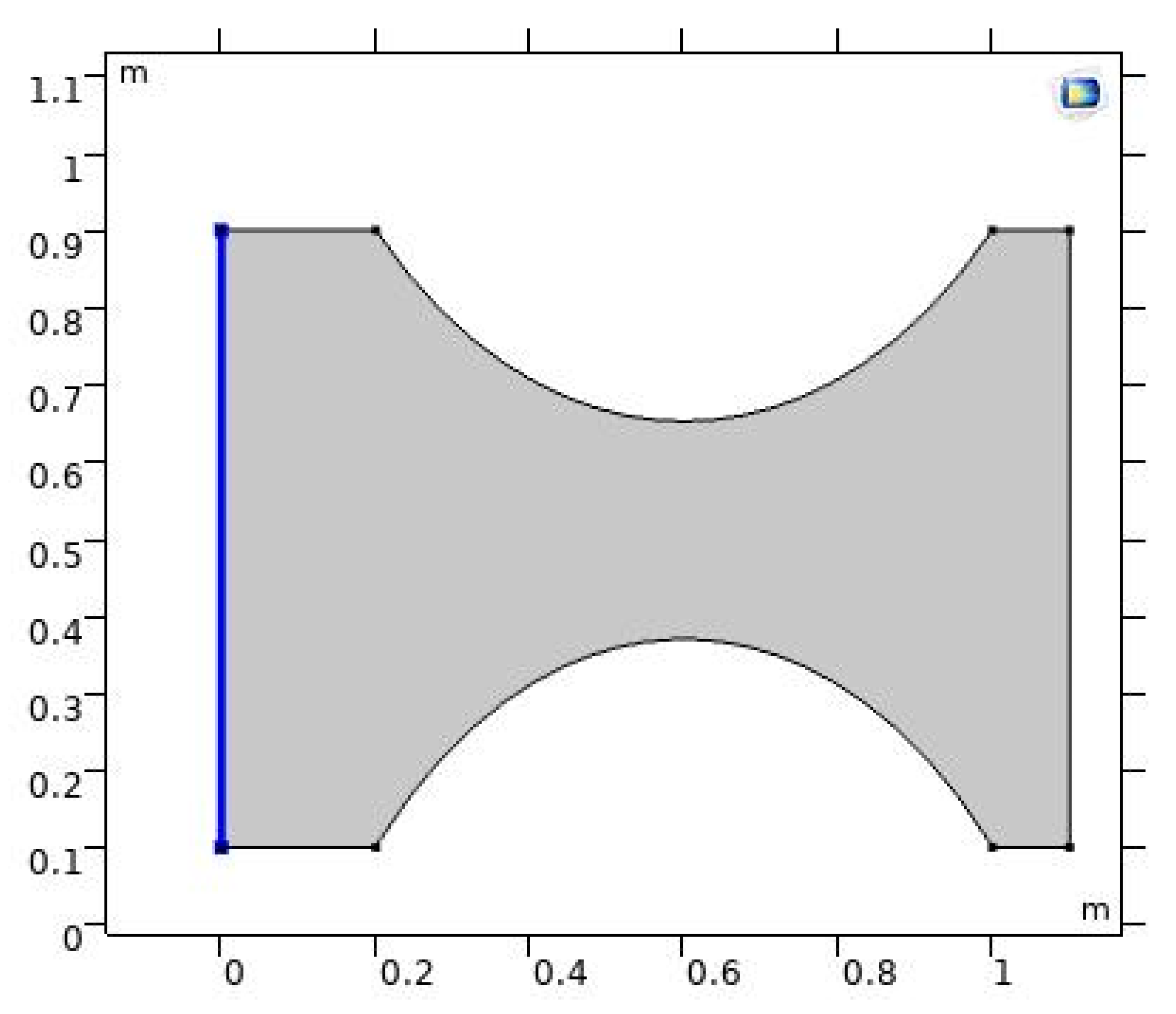

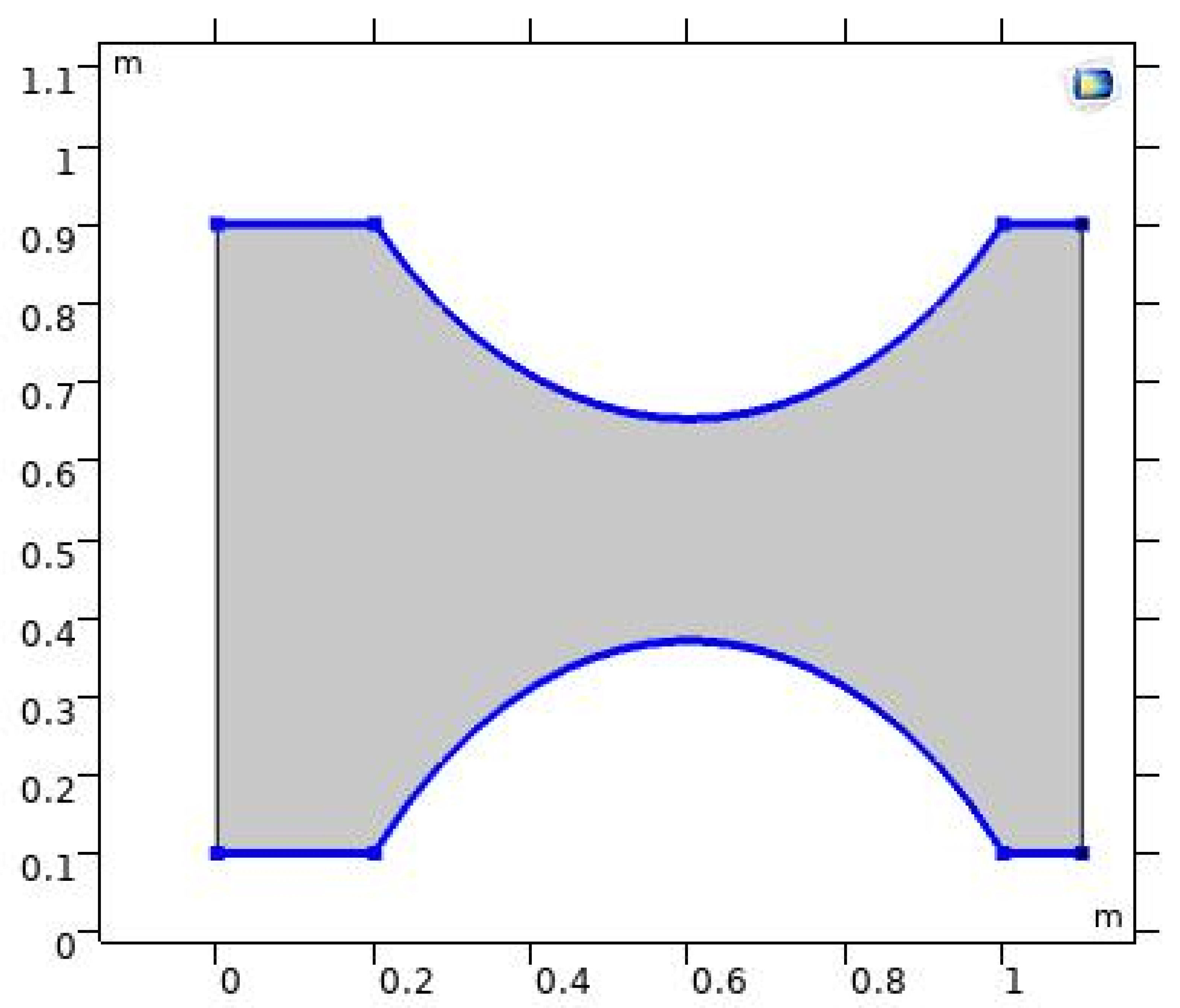
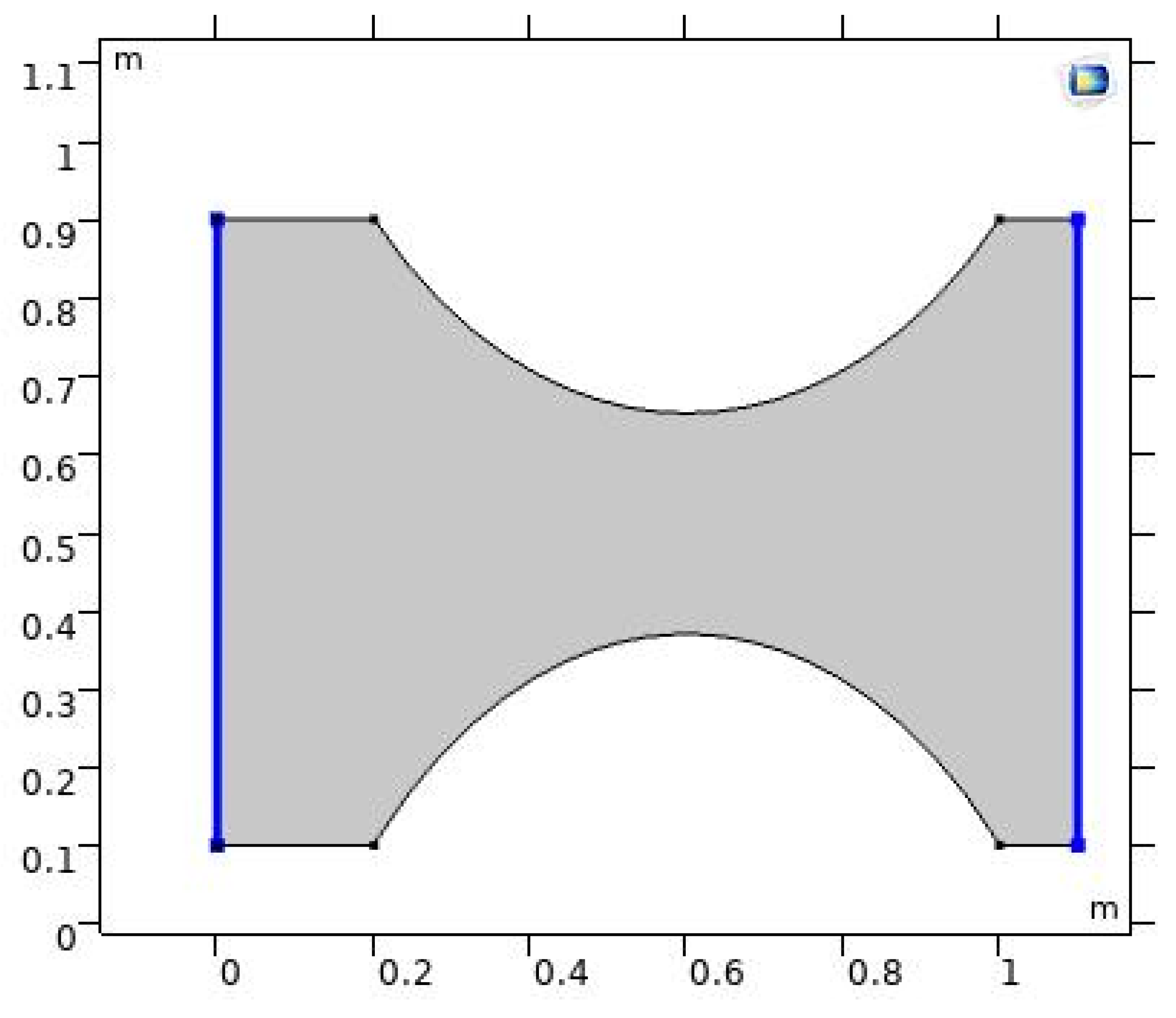
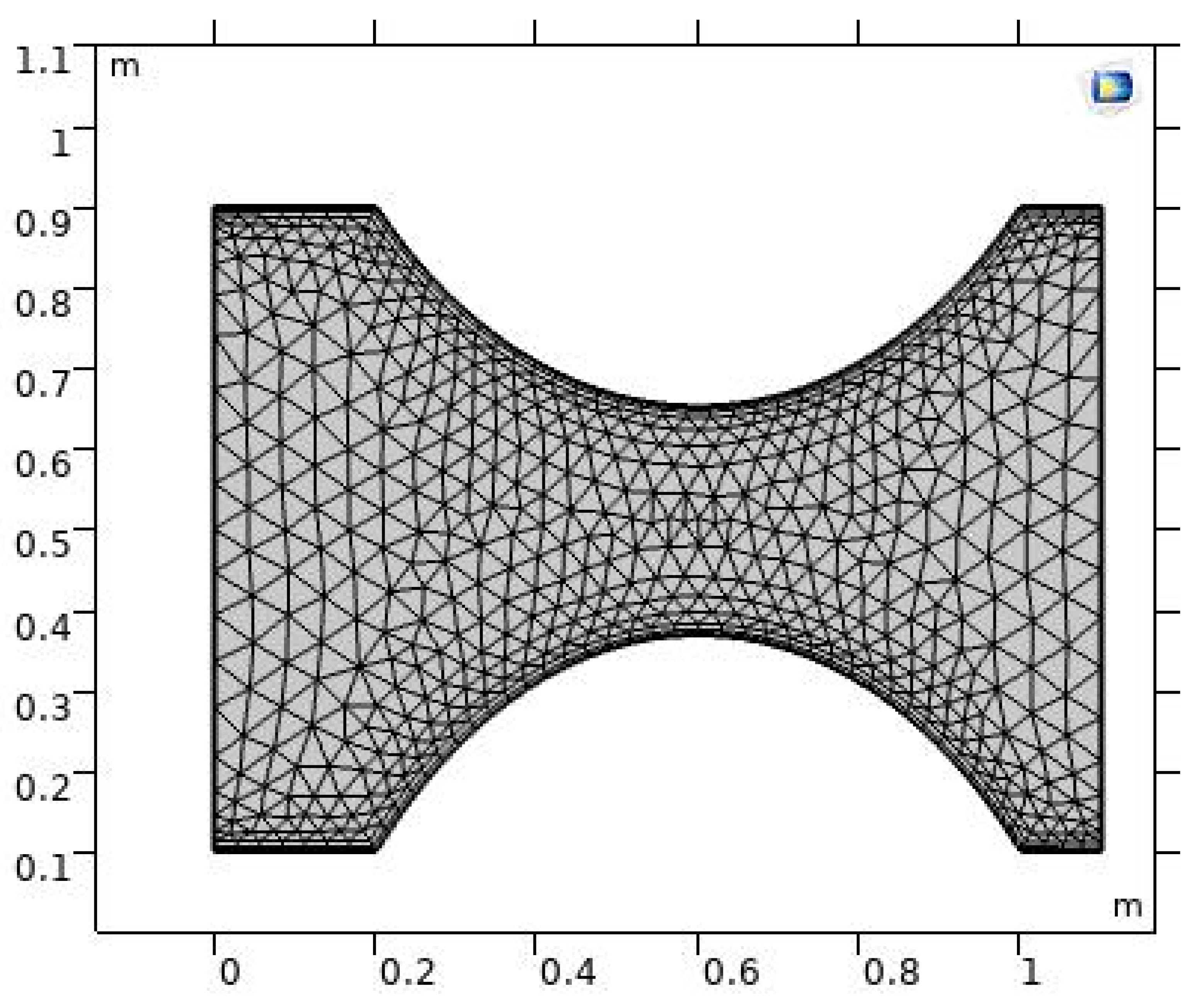
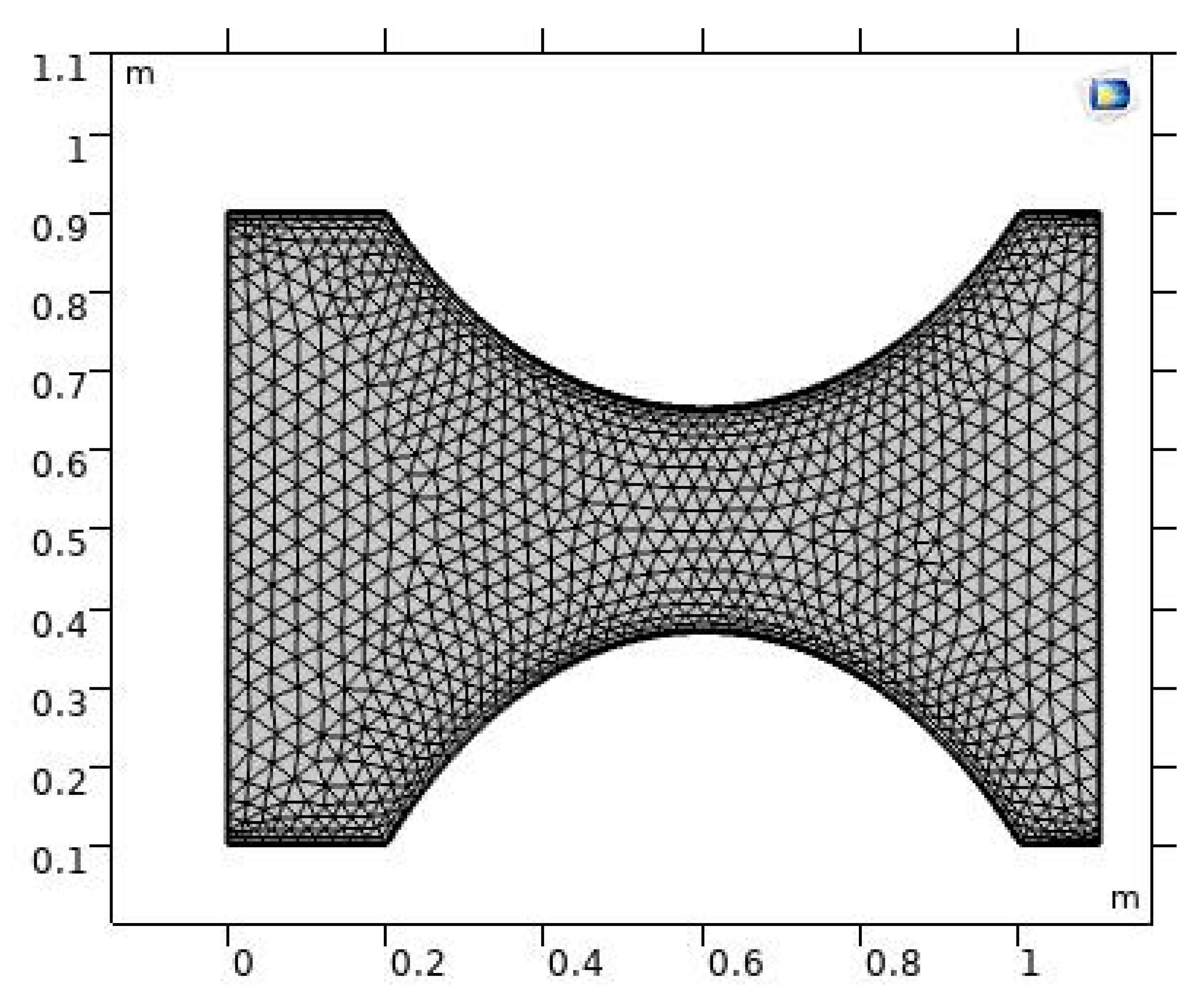
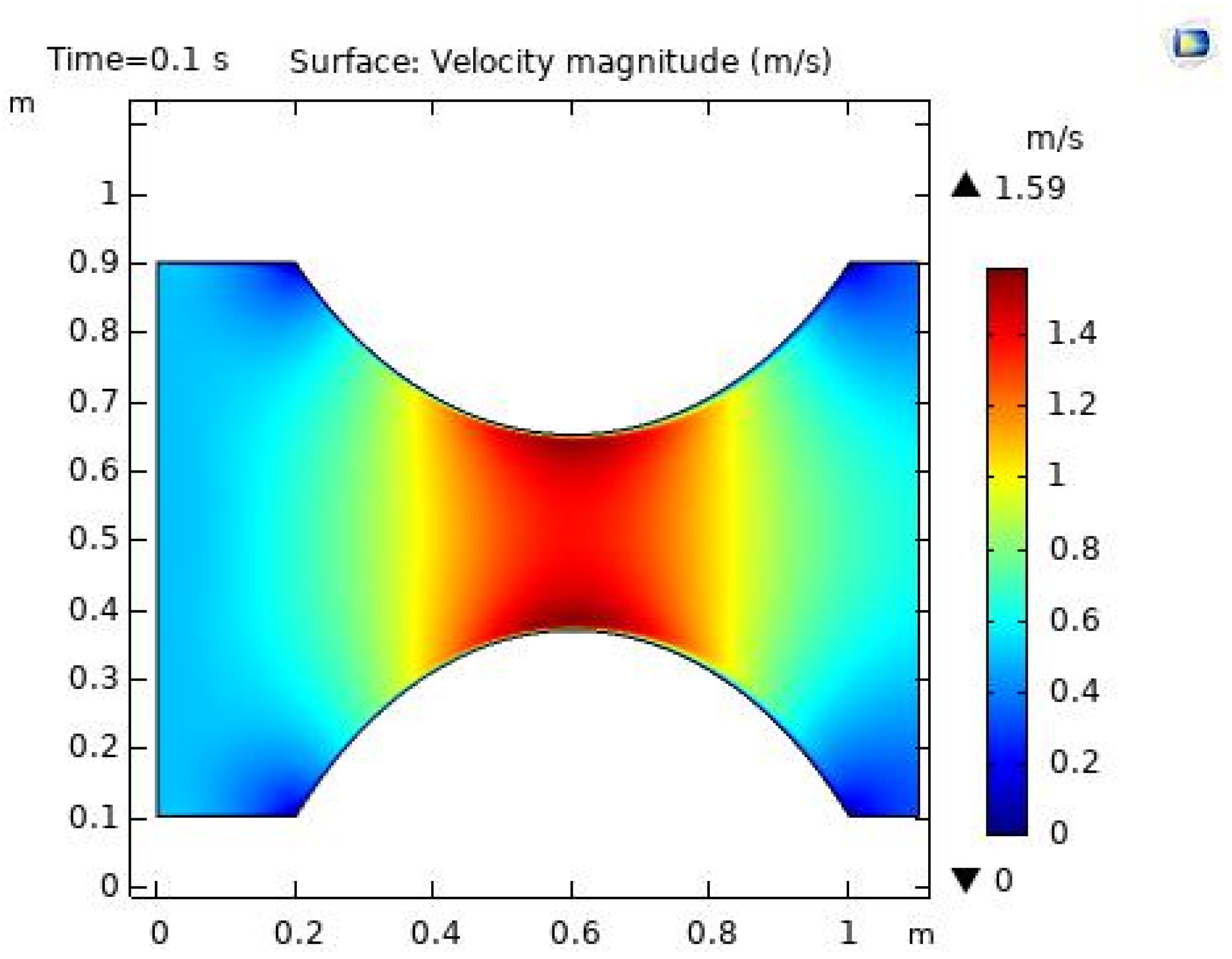
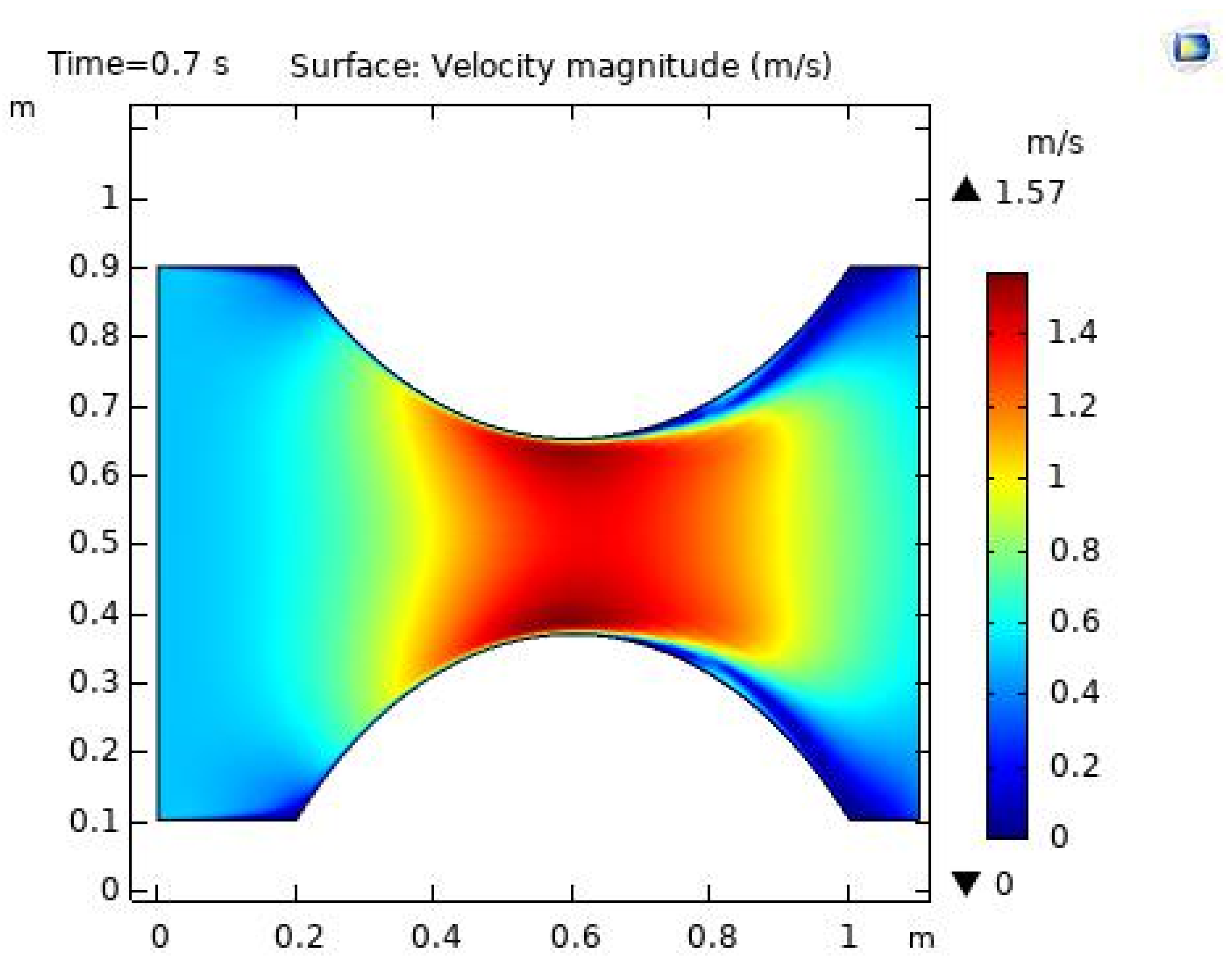
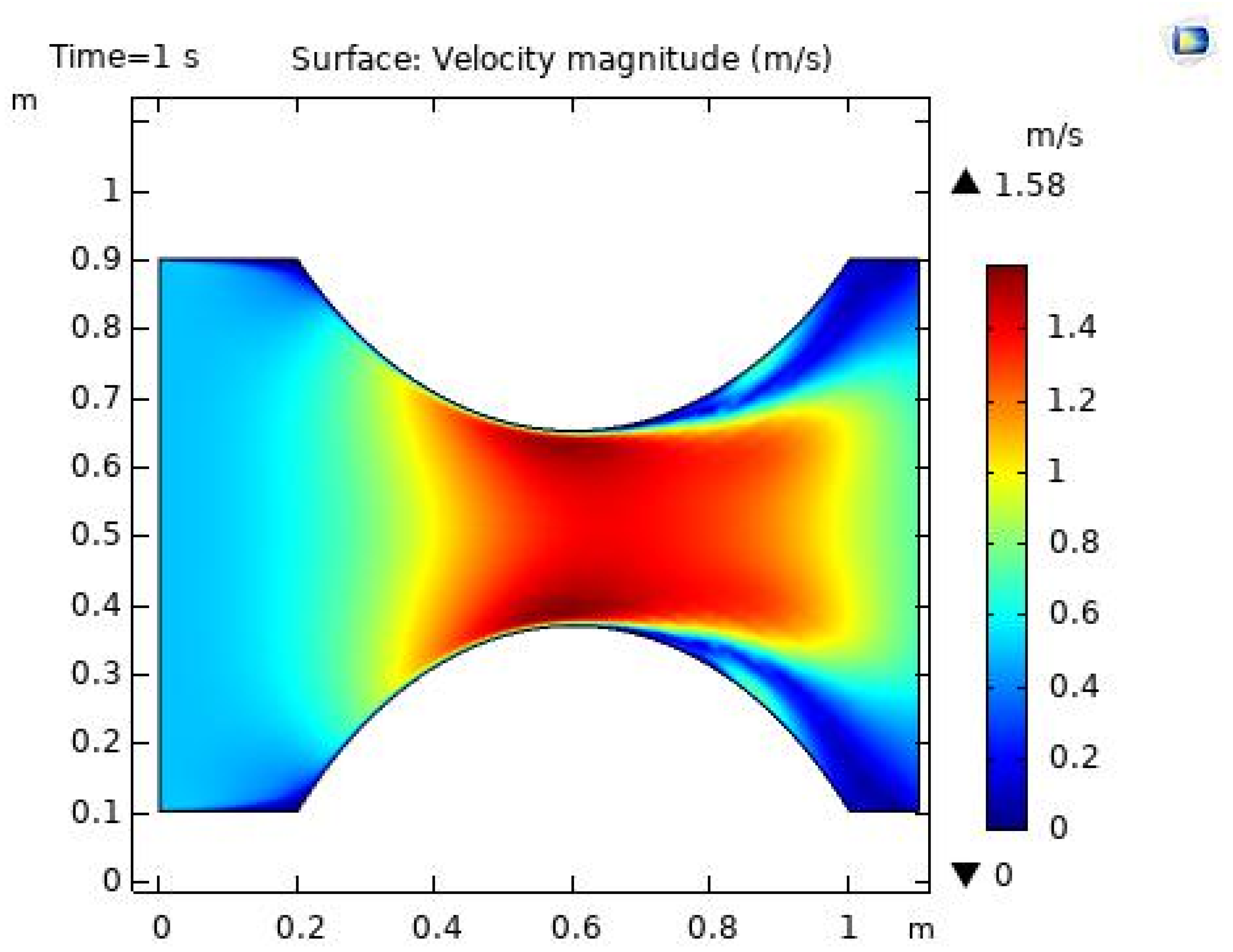
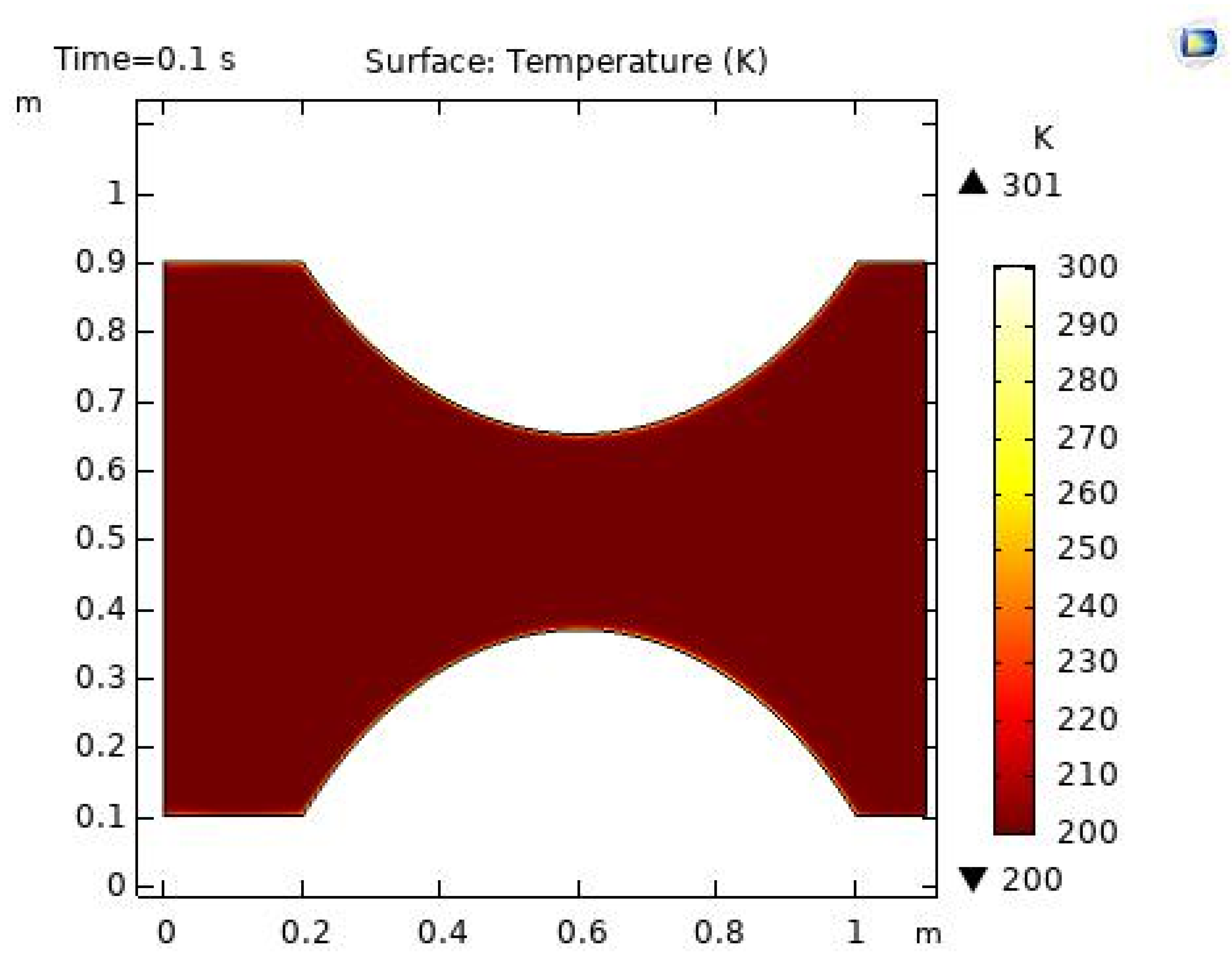
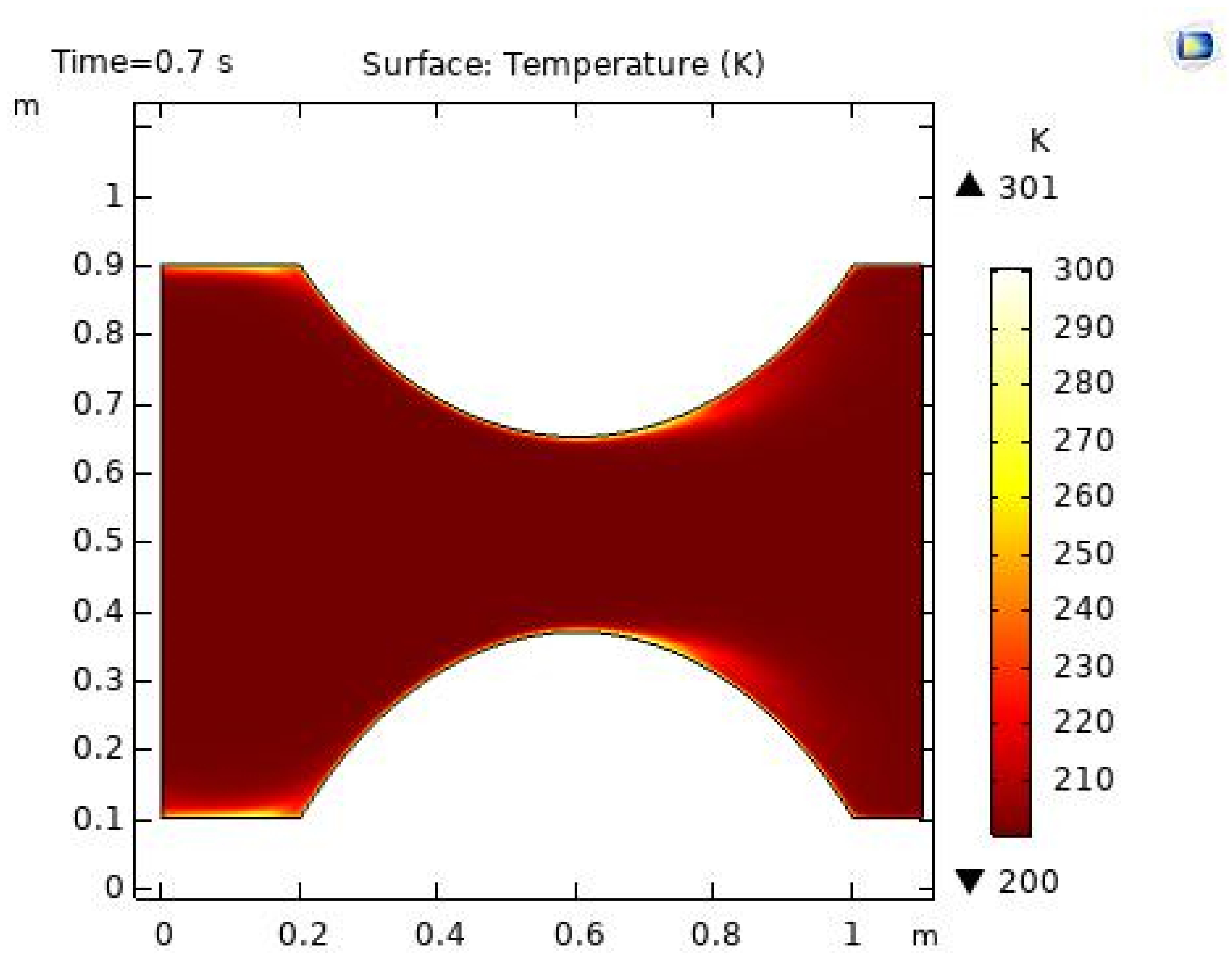
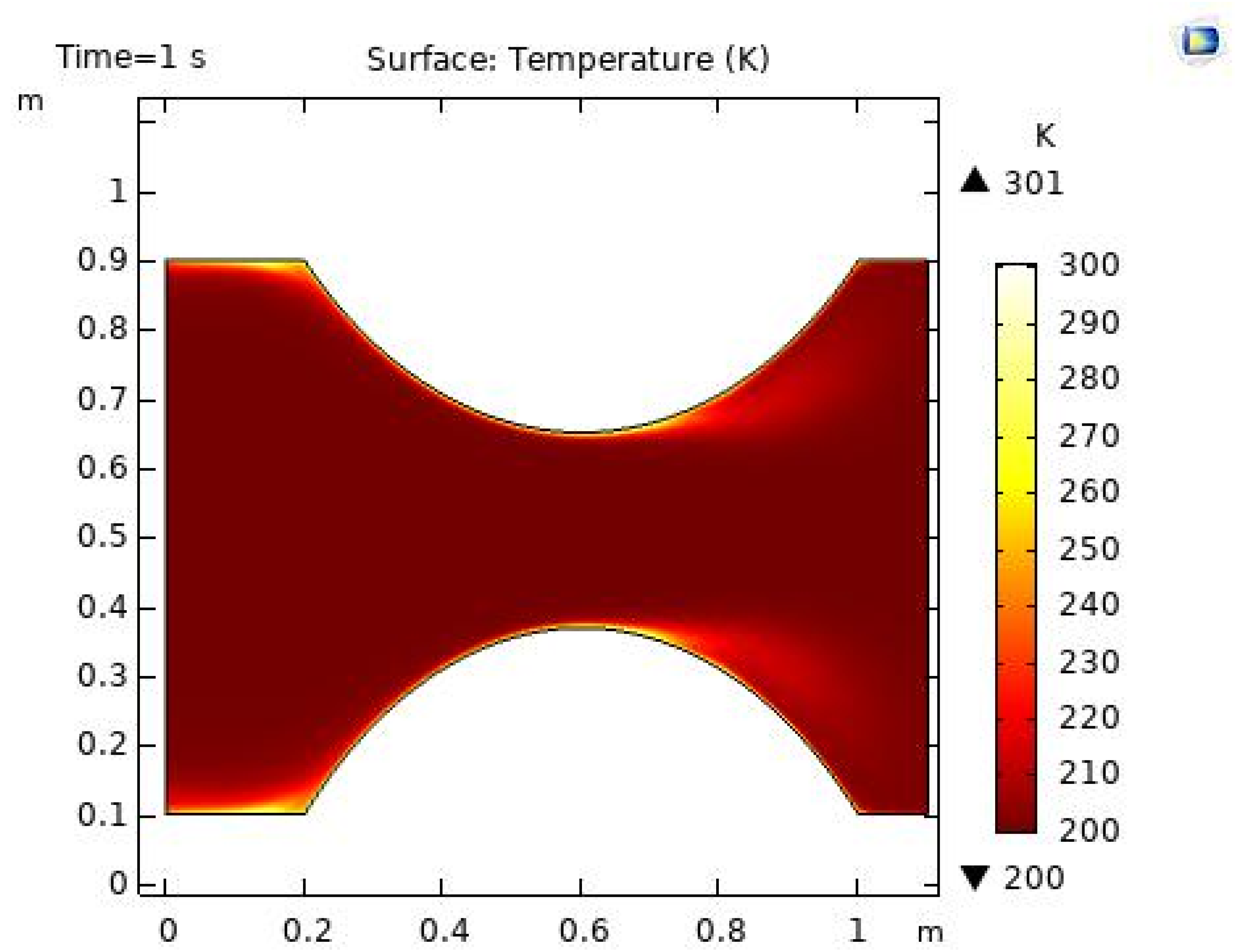
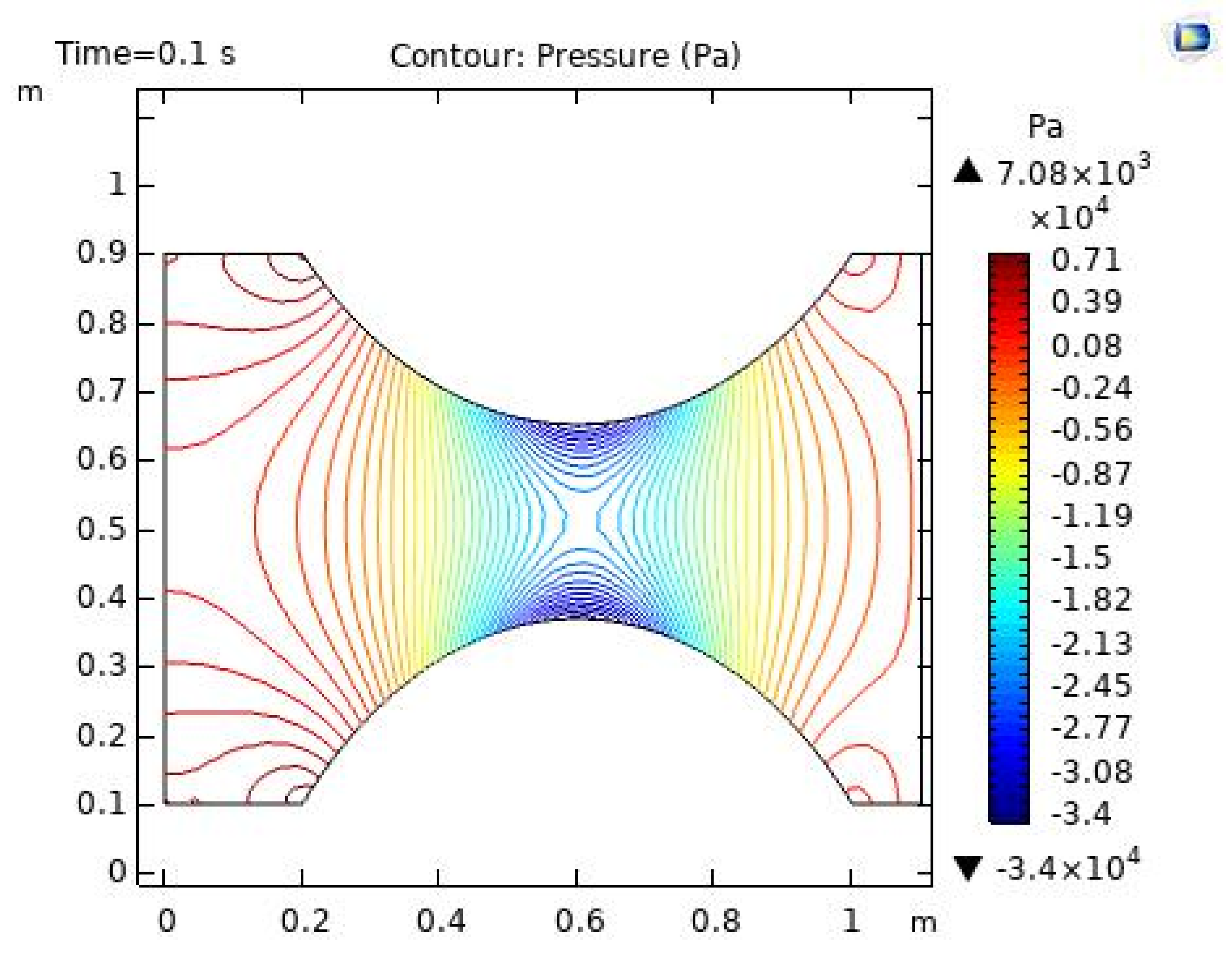
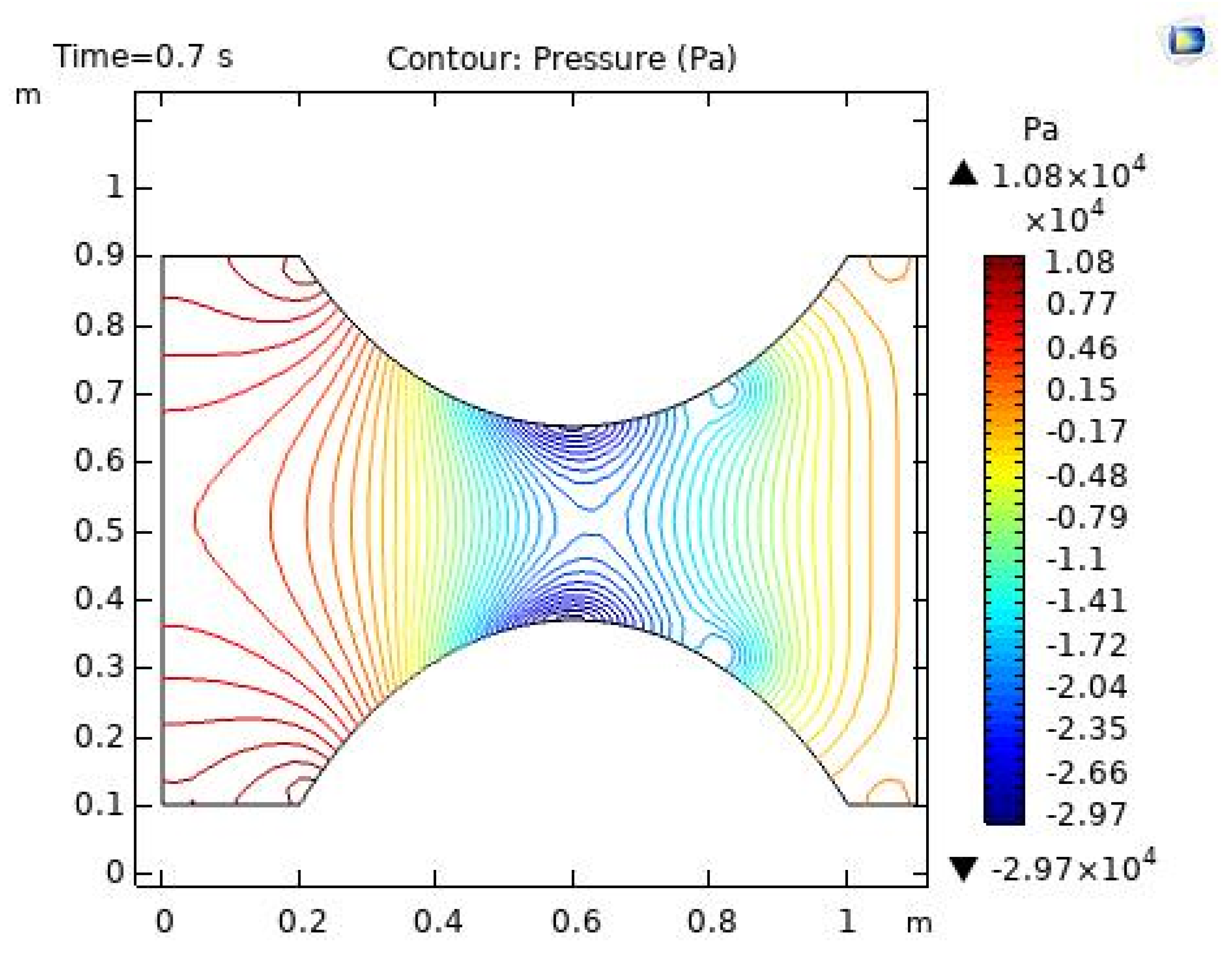
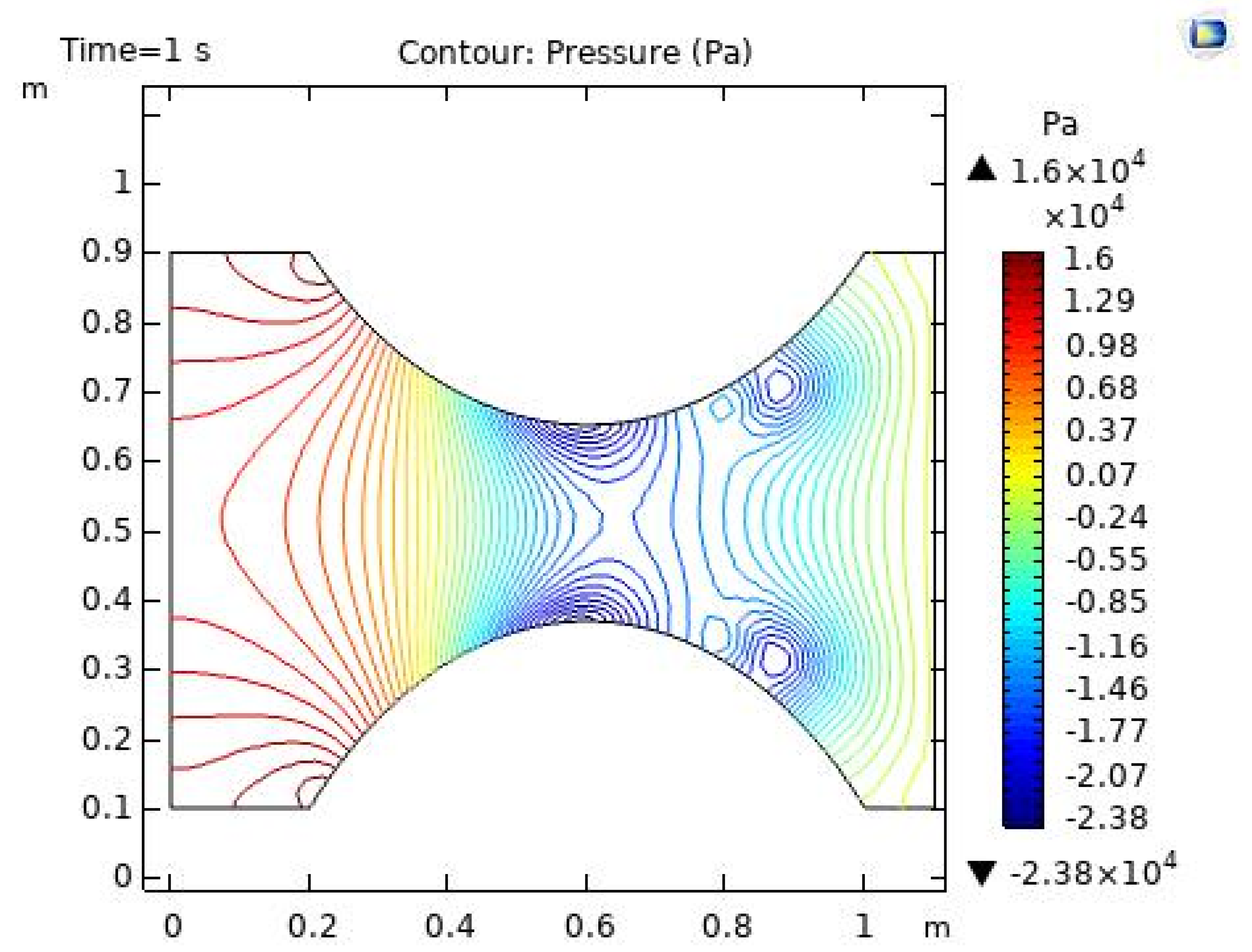
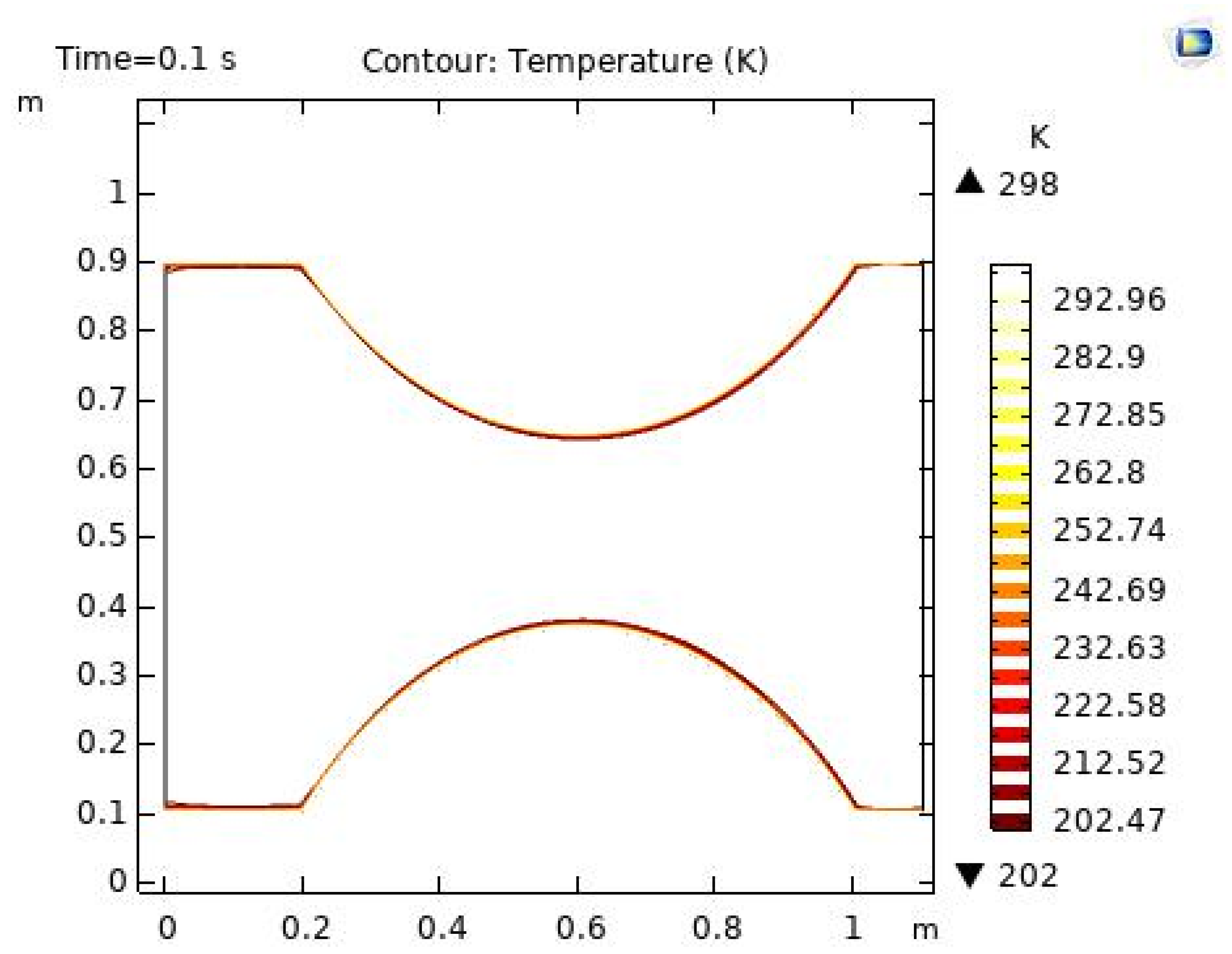
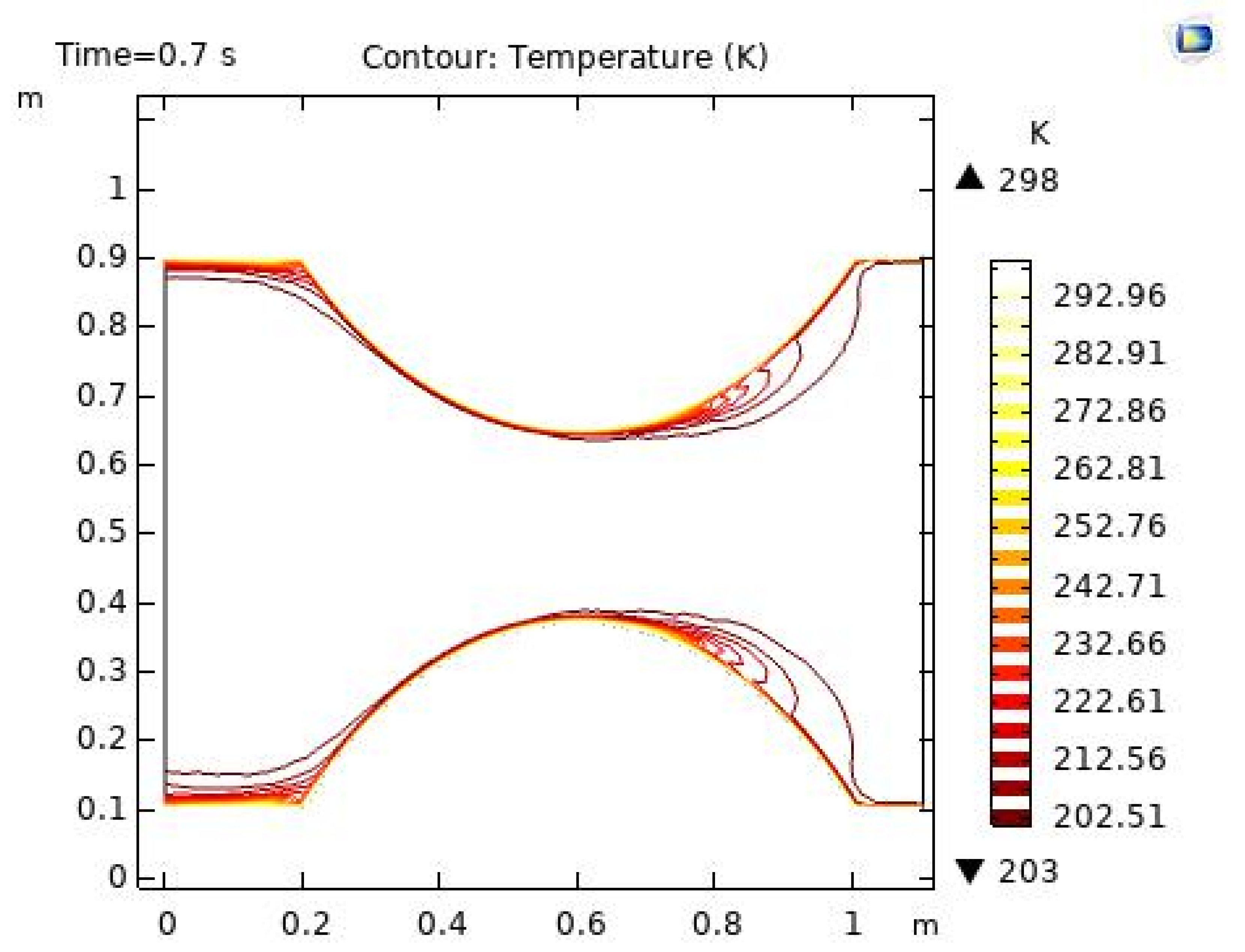
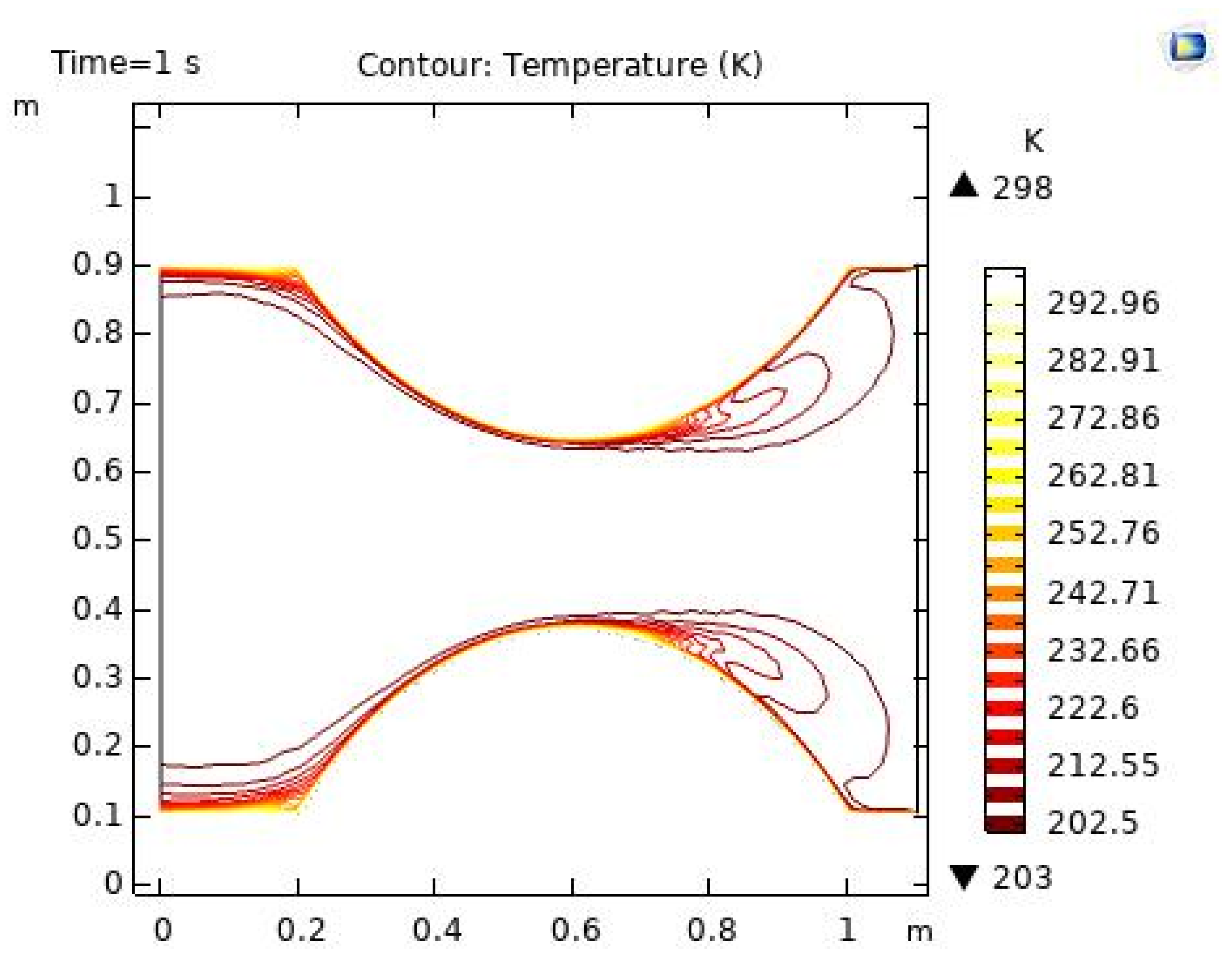
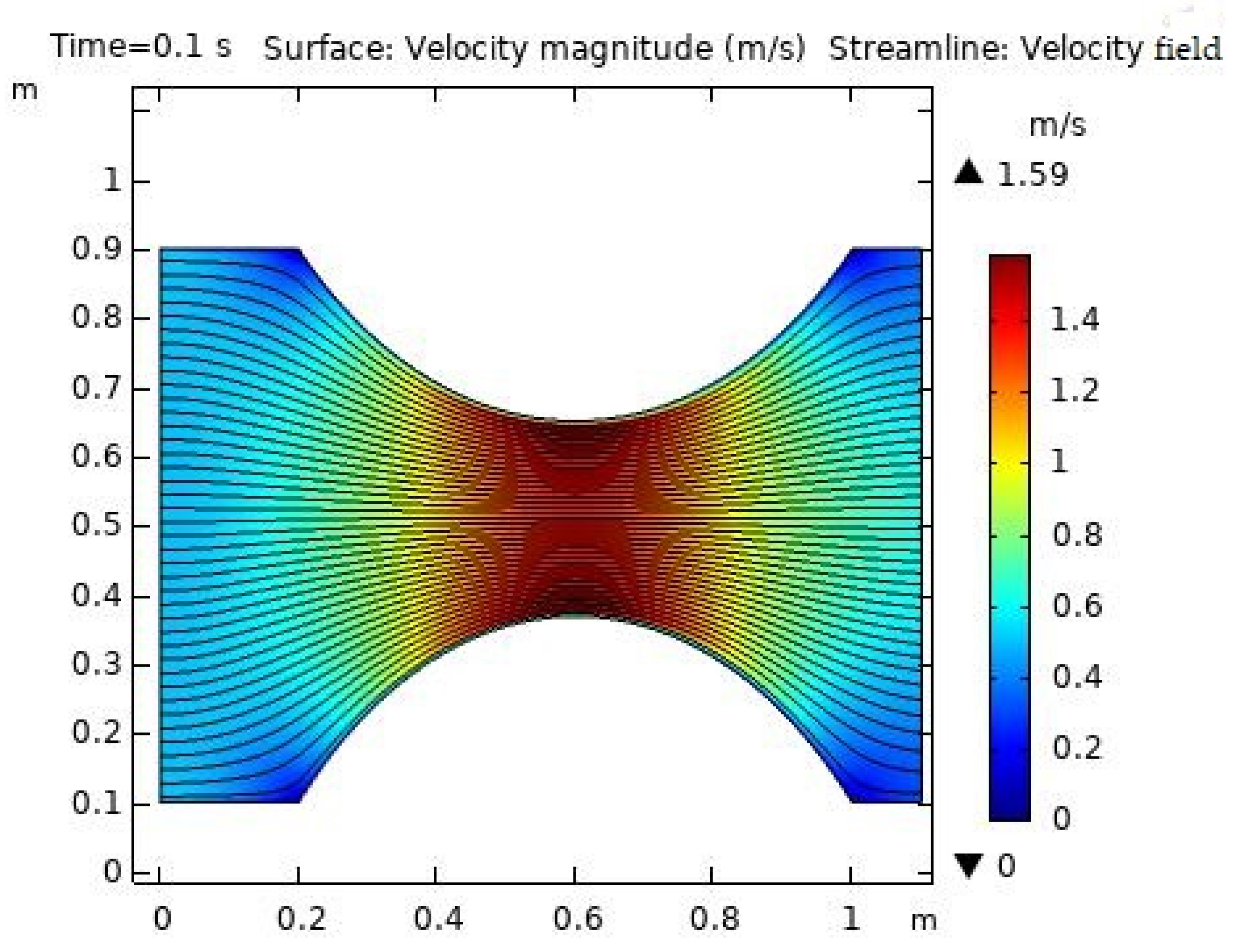
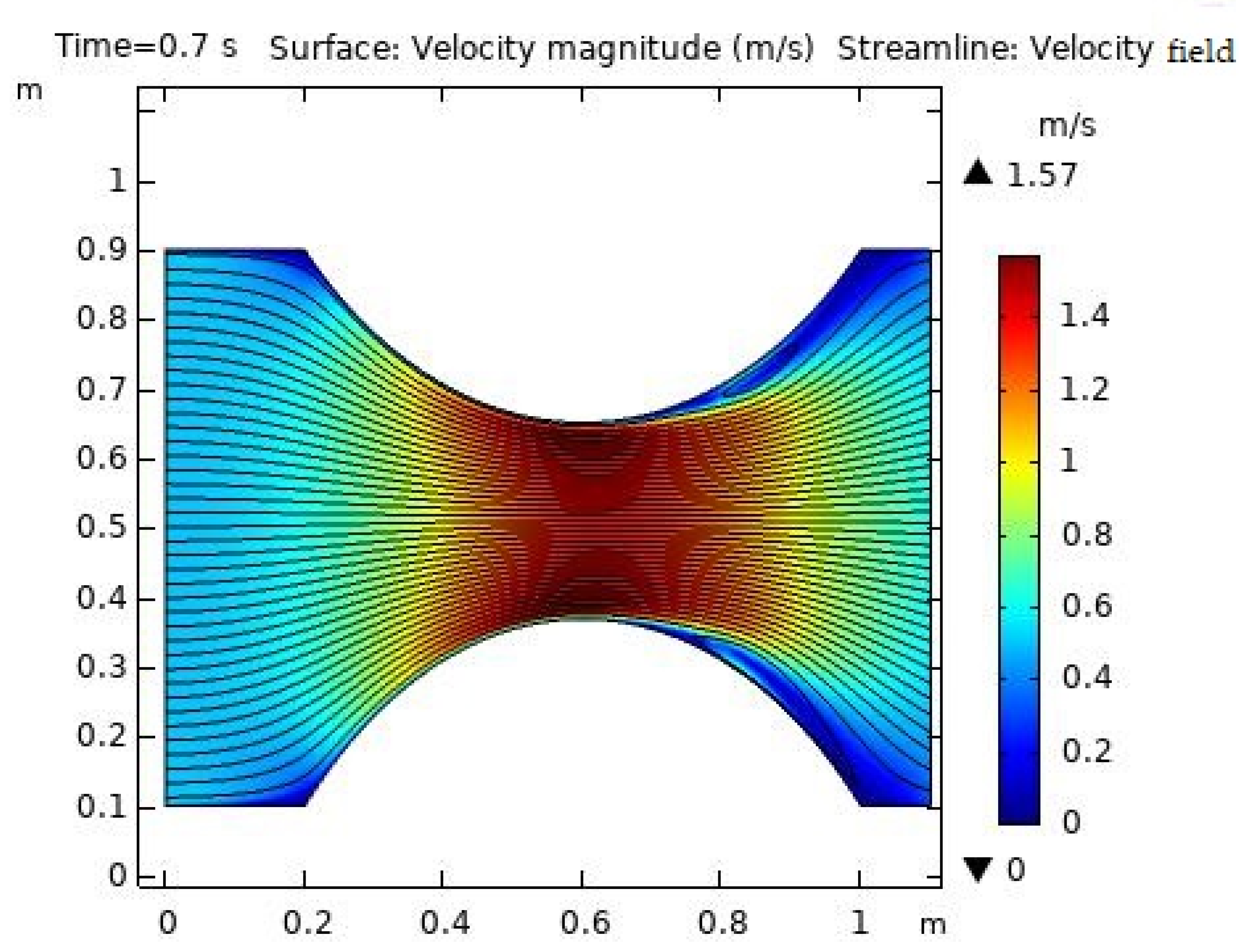
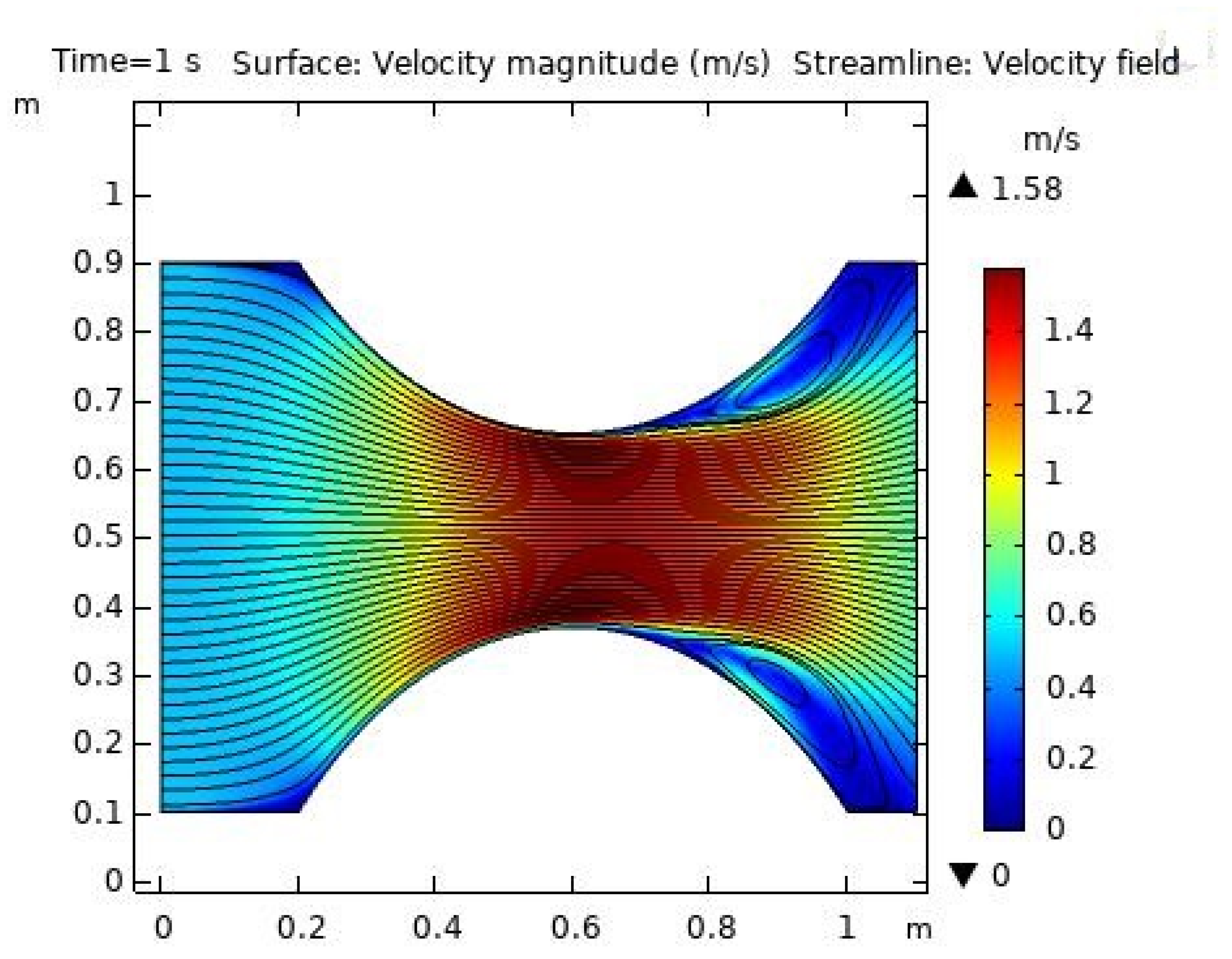
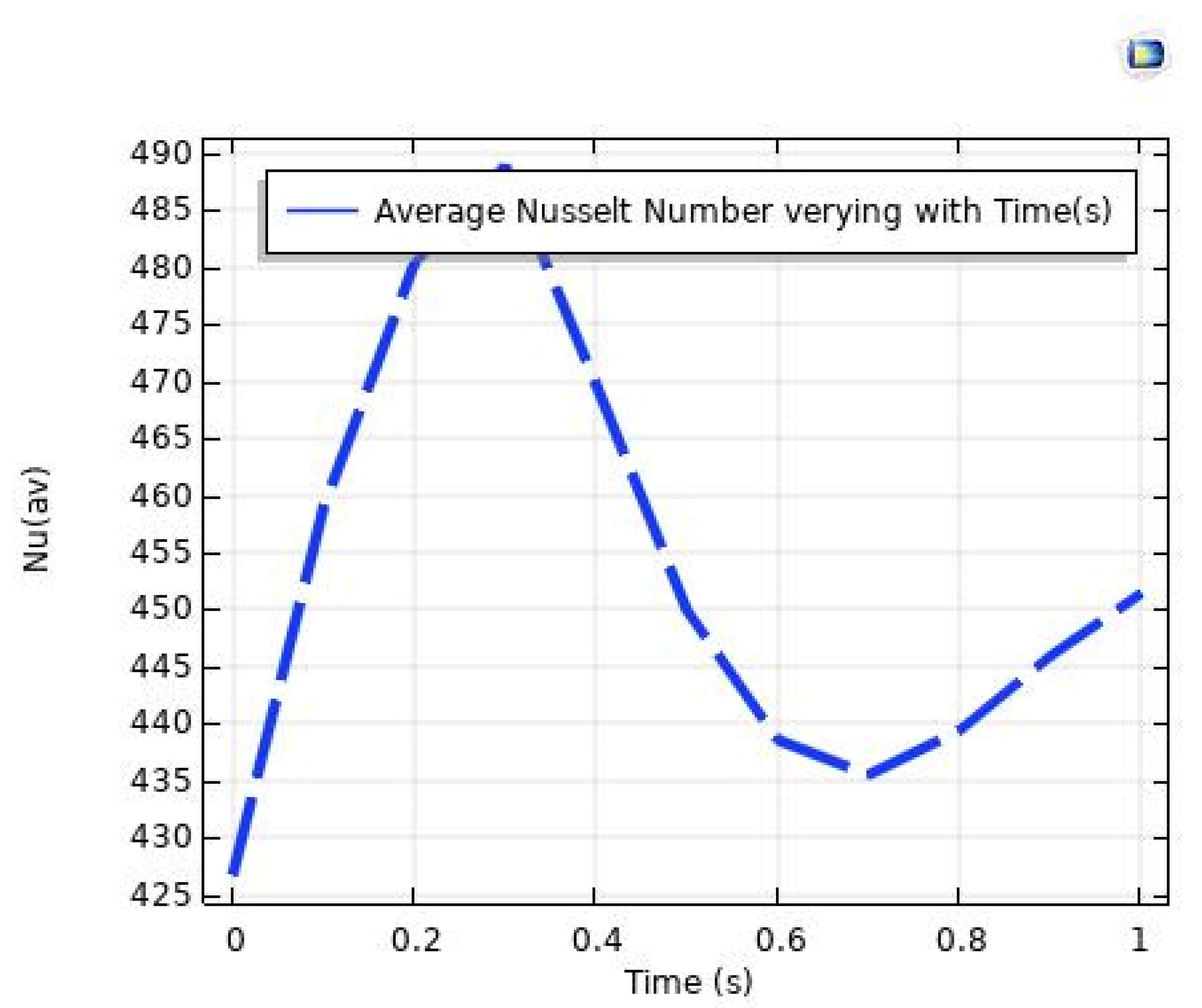
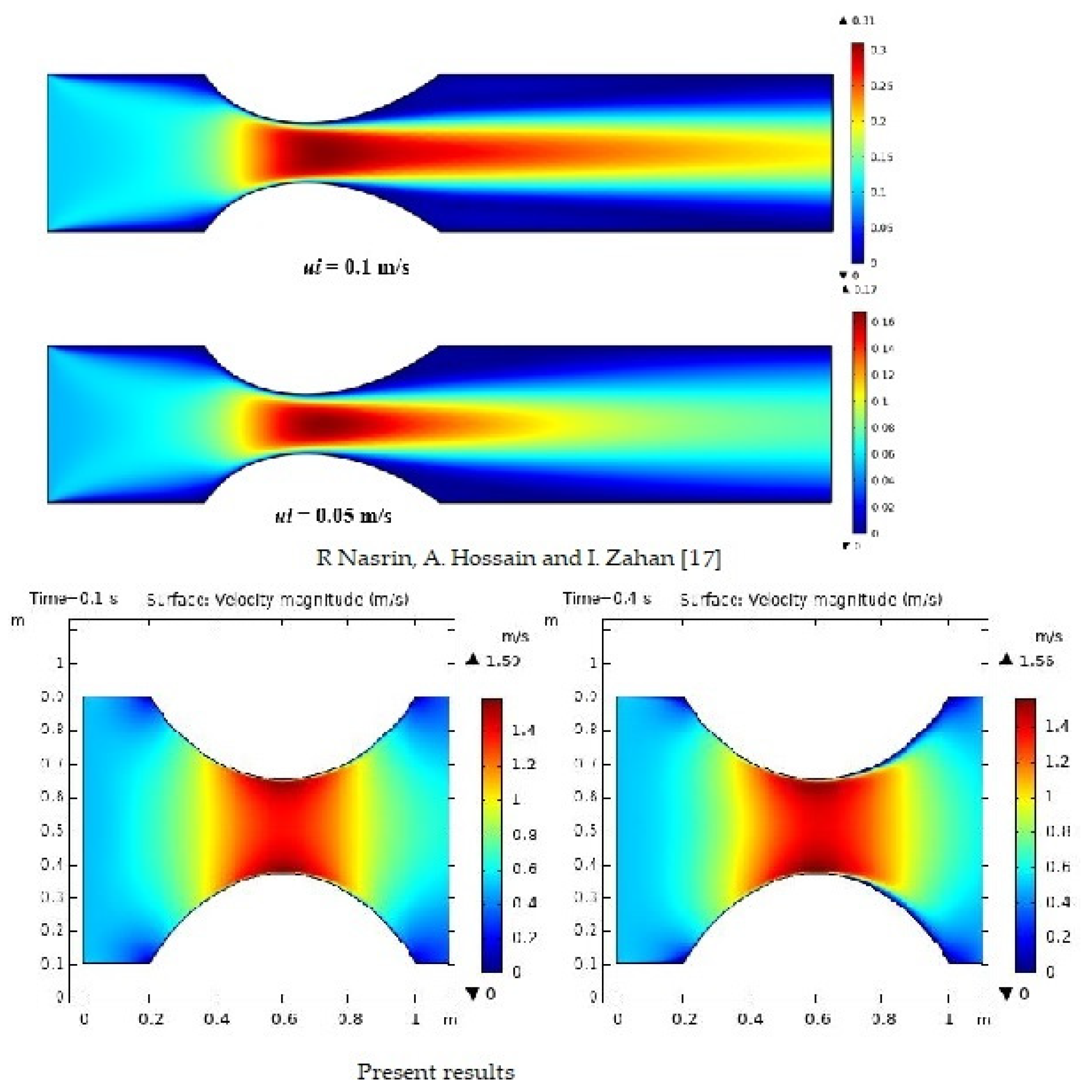
| Elements | Element Size | Mesh Area | |
|---|---|---|---|
| Mesh 1 | Normal | 0.5949 m2 | |
| Present study | Mesh 2 | Fine | 0.5948 m2 |
| Property | Value |
|---|---|
| Mesh vertices | 1195 |
| Edge elements | 173 |
| Quadrilateral entities | 234 |
| Triangles | 1747 |
| Vertex elements | 8 |
| Average element quality | 0.8291 |
| Minimum element quality | 0.3539 |
| Mesh area | 0.5948 m2 |
| Total no. of elements | 1981 |
| Ratio area of element | 0.06767 |
| Property | Value |
|---|---|
| Maximum element growth rate | 1.13 |
| Maximum element size | 0.028 |
| Minimum element size | 8 × 10−4 |
| Curvature factor | 0.3 |
| Resolution of narrow region | 1 |
| Geometric entity level | Entire geometry |
| Property | Variable | Blood | Gold | Silver | Unit |
|---|---|---|---|---|---|
| Dynamic viscosity | 0.003 | 0.00464 | 0.005 | Pa. s | |
| Heat capacity | 3746 | 129 | 235 | J/(kg. K) | |
| Thermal conductivity | K | 0.52 | 310 | 429 | W/(m. K) |
| Density | 1063 | 19,300 | 10,500 | Kg/m2 |
Publisher’s Note: MDPI stays neutral with regard to jurisdictional claims in published maps and institutional affiliations. |
© 2022 by the authors. Licensee MDPI, Basel, Switzerland. This article is an open access article distributed under the terms and conditions of the Creative Commons Attribution (CC BY) license (https://creativecommons.org/licenses/by/4.0/).
Share and Cite
Hussain, A.; Sarwar, L.; Rehman, A.; Akbar, S.; Gamaoun, F.; Coban, H.H.; Almaliki, A.H.; Alqurashi, M.S. Heat Transfer Analysis and Effects of (Silver and Gold) Nanoparticles on Blood Flow Inside Arterial Stenosis. Appl. Sci. 2022, 12, 1601. https://doi.org/10.3390/app12031601
Hussain A, Sarwar L, Rehman A, Akbar S, Gamaoun F, Coban HH, Almaliki AH, Alqurashi MS. Heat Transfer Analysis and Effects of (Silver and Gold) Nanoparticles on Blood Flow Inside Arterial Stenosis. Applied Sciences. 2022; 12(3):1601. https://doi.org/10.3390/app12031601
Chicago/Turabian StyleHussain, Azad, Lubna Sarwar, Aysha Rehman, Sobia Akbar, Fehmi Gamaoun, Hasan Huseyin Coban, Abdulrazak H. Almaliki, and Maram S. Alqurashi. 2022. "Heat Transfer Analysis and Effects of (Silver and Gold) Nanoparticles on Blood Flow Inside Arterial Stenosis" Applied Sciences 12, no. 3: 1601. https://doi.org/10.3390/app12031601
APA StyleHussain, A., Sarwar, L., Rehman, A., Akbar, S., Gamaoun, F., Coban, H. H., Almaliki, A. H., & Alqurashi, M. S. (2022). Heat Transfer Analysis and Effects of (Silver and Gold) Nanoparticles on Blood Flow Inside Arterial Stenosis. Applied Sciences, 12(3), 1601. https://doi.org/10.3390/app12031601







